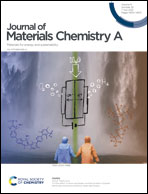Maintaining pronounced proton transportation of solid oxides prepared with a sintering additive†
Abstract
Proton-conducting electrolytes (PCEs) have led to significant advances in the fields of solid-state ionics, energy conversion and high-temperature electrochemistry, providing the basis of various solid oxide devices that demonstrate outstanding performance and efficiency. Although the proton transport of PCEs has an undeniable advantage over the oxygen-ion transport of conventional complex oxide approaches, the refractory nature of these materials presents significant challenges for their fabrication in the form of thin films. In order to mitigate sintering conditions for multilayered PCE structures (single cells), various additives have been used. However, other fundamental and technological issues arise in this connection, including the localization of such introduced impurities near grain boundaries resulting in blocked proton transportation. The present article reports a general strategy for effectively sintering PCE-based refractory materials while maintaining their hydrogen transportation, using a BaSn0.8Sc0.2O3−δ model compound due to its significant water uptake even at high levels of acceptor doping. This strategy, as shown in a comprehensive analysis of corresponding experimental results, proposes a CuO sintering additive in low amounts, sufficient for achieving a dense state with no adverse effects on protonic conduction. The reported findings can be applied for scalable preparation of gas tight PCEs at reduced sintering temperatures for various electrochemical purposes.



 Please wait while we load your content...
Please wait while we load your content...